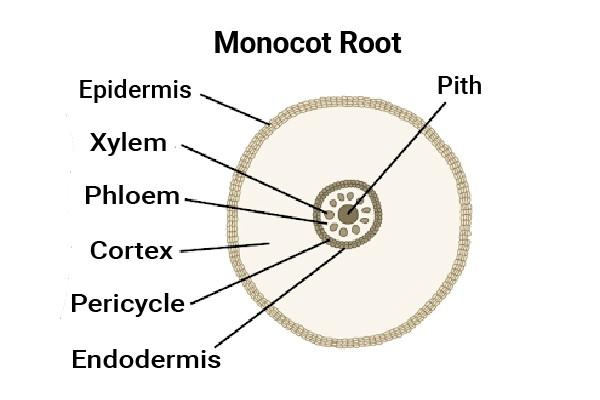
A typical monocotyledonous root is characterized by
A. Usually more than six xylem bundles
B. Large and well-developed pith
C. No secondary growth
D. All of the above
Answer
580.8k+ views
Hint: The roots of monocots cannot grow in diameter due to the lack of vascular cambium. In dicots, there is secondary growth which makes the plants have woody stems.
Complete answer: Monocot roots are characterized by the presence of (8 or more in number) alternate and radial xylem and phloem bundles.
This condition of the xylem is known as polyarch condition.
The central portion of the cross-section of a monocot root is occupied by a large pith consisting of thin-walled parenchyma cells spaced with intercellular spaces.
These cells may be round or angular in shape and are filled with abundant starch grain.
The vascular bundles are arranged in the form of a ring around the well-developed central pith.
Monocots don’t undergo secondary growth throughout their life cycle, instead, they grow more roots at the shoot and send out typical creeping shoots known as runners or rhizomes.

So, the correct answer is option D. All of the above.
Note: There is no distinction between a young and an old root of the monocotyledonous plant. This is due to the absence of secondary growth in the monocot roots.
Complete answer: Monocot roots are characterized by the presence of (8 or more in number) alternate and radial xylem and phloem bundles.
This condition of the xylem is known as polyarch condition.
The central portion of the cross-section of a monocot root is occupied by a large pith consisting of thin-walled parenchyma cells spaced with intercellular spaces.
These cells may be round or angular in shape and are filled with abundant starch grain.
The vascular bundles are arranged in the form of a ring around the well-developed central pith.
Monocots don’t undergo secondary growth throughout their life cycle, instead, they grow more roots at the shoot and send out typical creeping shoots known as runners or rhizomes.

So, the correct answer is option D. All of the above.
Note: There is no distinction between a young and an old root of the monocotyledonous plant. This is due to the absence of secondary growth in the monocot roots.
Recently Updated Pages
Master Class 12 Business Studies: Engaging Questions & Answers for Success

Master Class 12 Economics: Engaging Questions & Answers for Success

Master Class 12 English: Engaging Questions & Answers for Success

Master Class 12 Maths: Engaging Questions & Answers for Success

Master Class 12 Social Science: Engaging Questions & Answers for Success

Master Class 12 Chemistry: Engaging Questions & Answers for Success

Trending doubts
The pH of the pancreatic juice is A 64 B 86 C 120 D class 12 biology CBSE

Explain sex determination in humans with the help of class 12 biology CBSE

Draw ray diagrams each showing i myopic eye and ii class 12 physics CBSE

Which state in India is known as the Granary of India class 12 social science CBSE

Using Huygens wave theory derive Snells law of ref class 12 physics CBSE

Dihybrid cross is made between RRYY yellow round seed class 12 biology CBSE




